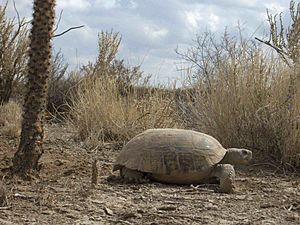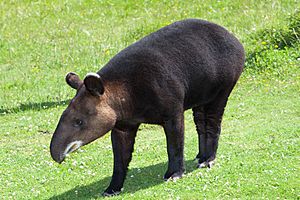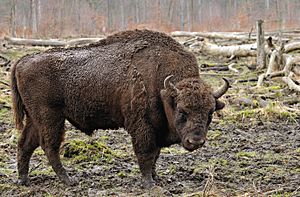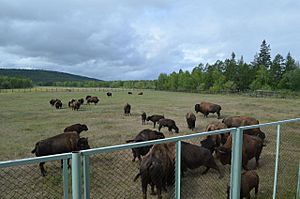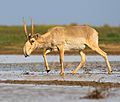Pleistocene rewilding facts for kids
Pleistocene rewilding is a big idea about bringing back large animals, called megafauna, to places where they used to live. It's like trying to fix nature by reintroducing species that disappeared a long time ago. This idea is part of a larger effort called rewilding, which means helping nature become wild again by bringing back animals that were lost in more recent times.
Around 13,000 to 10,000 years ago, at the end of the Pleistocene Ice Age, many huge animals in places like Europe, Asia, Australia, and North and South America started to disappear. This event is known as the Quaternary extinction event. When these large plant-eaters (herbivores) and predators vanished, they left empty spaces in the ecosystem. It was like important jobs in nature were left undone. For example, in North American national parks, people sometimes have to control the number of ungulates (deer-like animals) because there are no longer enough big predators to do it naturally.
Some scientists, like Paul S. Martin, believe that nature in North America isn't working as it should. This is because many plants and animals there grew up with large mammals around. Without them, things are out of balance.
Contents
Why Bring Back Big Animals?
Helping Nature and Evolution
Scientists have found that how different species interact is super important for keeping nature healthy. In places where animals used to live alongside huge Ice Age creatures, but now don't, the whole natural system might be in danger. Most of the very large animals still alive today are threatened or endangered. These big animals have a huge impact on their environments. This shows that ecosystems really do need large mammals.
Pleistocene rewilding could create new safe homes, called refugia, for today's megafauna. This would help save their unique evolutionary potential. Bringing back large animals to North America could protect current megafauna. It would also fill the empty roles in nature that have been open since the Pleistocene.
Fighting Climate Change
Sergey Zimov, a Russian scientist, thinks that Pleistocene rewilding could help bring back the ancient mammoth steppe ecosystem. This is a type of grassland that was common during the Ice Age. He believes that restoring this ecosystem could slow down the melting of the Arctic permafrost (frozen ground). This would give the world more time to deal with climate change.
Zimov thinks the mammoth steppe disappeared because humans hunted too much, not just because of natural climate changes. He has even created Pleistocene Park in Siberia and Wild Field in European Russia. Here, he is trying to restore grasslands by bringing back animals that lived on the mammoth steppe, or animals that are similar to them.
Animals for North America
Pleistocene rewilding in the southwestern and central United States aims to bring back animals that are still alive today. It also wants to reintroduce types of animals that went extinct. The first animals suggested are those that are native to the area.
The Bolson tortoise was common during the Pleistocene era and for a long time after. Bringing it back from northern Mexico would help make the soil moist again, which is good for grasslands and shrubs. This would create homes for other plant-eating animals. Other large tortoise species might also be brought in later.
The pronghorn is another important animal. It almost disappeared but is now found in many western areas. Pronghorns are native to the region and would live on the great plains.
Plains bison used to number in the millions during the Pleistocene and later. European settlers almost wiped them out in the late 1800s. But bison have made a comeback in many areas. They are now part of several local rewilding projects across the Midwestern United States.
Bighorn sheep and mountain goats already live in the mountains nearby. Reintroducing different types of deer, like elk, white-tailed deer, and mule deer, to forested areas would also be good for nature. They provide food and help keep the forests healthy.
Other plant-eating animals that could help include the collared peccary. This pig-like animal was common during the Pleistocene. Even though it's gone from many parts of North America, its relatives still live in Central and South America. The collared peccary can still be found in southern Arizona, New Mexico, and Texas.
Horses first appeared in North America. They spread to Asia across the Ice Age land bridge. But they died out in their homeland along with the mammoth and ground sloth. The grasslands of Pleistocene North America were where modern horses began. Przewalski's horse is a wild horse that is good at living in dry, grassy areas. It could be brought in to replace its close North American relative, Scott's horse.
Camels also evolved in the drier regions of North America. Though they are gone from North America, they still live in South America. The guanaco and vicuña are good choices to bring back. They would live in the dry and grassy areas of North America.
During the Pleistocene, a species of tapir lived in North America. These tapirs died out at the end of the Pleistocene era. But their relatives still live in Asia and South America. The mountain tapir would be a great choice for rewilding humid areas, like near lakes and rivers. It's the only tapir that doesn't live in tropical places.
Huge elephant-like animals called Proboscideans, like the Columbian mammoth and the American mastodon, lived in North America during the Pleistocene. They all died out. However, a living relative of the mammoth is the Asian elephant. Even though it now lives only in tropical Asia, it used to live in cooler places like northern China. The Asian elephant might be a good choice for Pleistocene rewilding in North America.
Pleistocene America had many dangerous meat-eaters. Some, like grizzly bears, cougars, and wolves, survived. The cheetah could be brought in to replace the extinct American cheetah. This would help control the number of pronghorns. Lions, like the African lion, could act like the extinct American lion. They would help keep the numbers of American bison, horses, and camels in check.
Why Some People Disagree
The main criticism of Pleistocene rewilding is that it's not realistic. Some people think that nature today is very different from 10,000 years ago. They argue that there has been plenty of time for ecosystems to change without large animals. So, bringing back huge mammals could mess up how nature works and even cause problems.
Those who disagree say that the animals brought in would be "exotic" (not native). They could harm North American native species by bringing diseases or other issues. Instead, they suggest bringing back animals that disappeared more recently. Another idea is "de-extinction", which means bringing extinct species back to life through cloning.
Rewilding in Europe
The idea of Pleistocene rewilding is also being looked at for parts of Europe. An effort called "Rewilding Europe" started in the Netherlands in 2011. It focuses on places like the Iberian Peninsula and the Danube delta.
Some animals that have already been brought back to Europe include:
- Fallow deer
- Musk ox
- European bison
- American bison (in Askania Nova, Ukraine)
- Water buffalo
- Ostrich
Some animals whose populations are growing naturally in Europe include:
- Alpine ibex
- Wolf
- Brown bear
- European beaver
- White-tailed eagle
For animals that went extinct in Europe but still have living relatives, scientists are looking at using domestic descendants. For example, various horse breeds like Konik are being used as a stand-in for the extinct tarpan. Strong cattle breeds are being used to replace the extinct aurochs.
Some species that are still alive outside Europe could also be brought back:
- Asian black bear
- Asian elephant (as a proxy for the extinct Straight-tusked elephant)
- Northern lion (as a proxy for the extinct European cave lion)
- Hippopotamus (for warmer parts of Europe)
- Saiga antelope (recently extinct in Eastern Europe)
Rewilding in Northern Siberia
The goal in Siberia is to bring back the ancient mammoth steppe ecosystem by reintroducing large animals. The first step was successfully bringing back musk oxen to the Taymyr Peninsula and Wrangel Island.
In 1988, scientist Sergey Zimov created Pleistocene Park in northeastern Siberia. It's a nature reserve for full-scale megafauna rewilding. Animals like reindeer, Siberian roe deer, and moose were already there. Yakutian horses, muskox, Altai wapiti, and wisent have been brought back. There are also plans to reintroduce yak, Bactrian camels, and Siberian tigers.
The wood bison is very important for Siberia's nature. It's the closest relative of the ancient bison that died out in Siberia long ago. In 2006, 30 bison calves were brought from Edmonton, Alberta to Yakutsk. They now live in a government reserve.
Animals already introduced to Pleistocene Park include:
- Domestic Yak
- Musk ox
- Wood bison
- Yakutian horse
Animals being considered for reintroduction:
Rewilding in Asia
Animals already introduced in Asia:
- Korean fox in Sobaeksan National Park and DMZ, South Korea
- Asian black bear in Jirisan National Park, South Korea
- Père David's deer in China
Animals being considered for reintroduction:
- Amur tiger
- Gray wolf in South Korea
- Malayan tapir in southern China
Rewilding on Islands
Large animals that lived on islands were very vulnerable to humans. This is because they evolved without many threats. Many island megafauna disappeared after humans arrived. So, scientists have suggested bringing in similar animals to replace them.
This is happening on several islands. For example, Aldabra giant tortoises have been suggested to replace the extinct Malagasy giant tortoises. In Mauritius, Malagasy radiated tortoises have been introduced to replace the tortoises that used to live there.
Tortoises are also being used in other ways. At the Makauwahi Cave Reserve in Hawaii, tortoises are being used to replace the extinct moa-nalo, a large flightless duck. These tortoises eat plants, which helps control invasive plants and encourages native plants to grow.
Rewilding in Australia
Animals already introduced in Australia:
- Tasmanian devil (to New South Wales)
Animals whose populations are growing:
Animals being considered for reintroduction:
- Komodo dragon (as a proxy for Megalania)
- Emu on Tasmania (as a proxy for extinct Tasmanian emus)
Rewilding in the British Isles
Animals already introduced:
Animals being considered for reintroduction:
Rewilding in Japan
Animals already introduced:
- Crested ibis on Sado Island in Japan
- Oriental stork in western Japan
Animals being considered for reintroduction:
- Dugong
- Eurasian wolf (as a proxy for the extinct Japanese wolf)
Rewilding in Maritime Southeast Asia
Animals being considered for reintroduction:
Images for kids
-
Henryk Sienkiewicz's novel With Fire and Sword opens with a description of saigas as a way to highlight the story's exotic setting Saigas are now extinct in Europe and are a critically endangered species.


